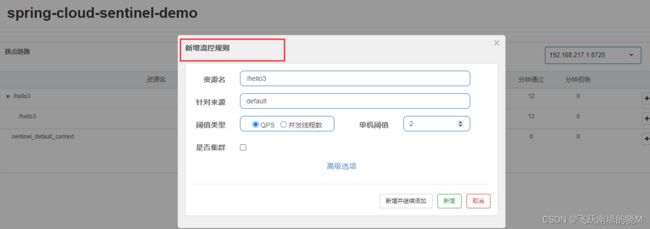三步实现 Sentinel-Nacos 持久化
一、背景
版本:【Sentinel-1.8.6】
模式:【Push 模式】
参照官网介绍:生产环境下使用Sentinel ,规则管理及推送模式有以下3种模式:
比较之后,目前微服务都使用了各种各样的配置中心,故采用Push 模式来进行持久化,这里也主要介绍集合 Nacos 的持久化。
二、流程结构图

实现思路说明:微服务中增加基于Nacos的写数据源(WritableDataSource),当 Sentinel Dashboard 配置发生变更,则利用 nacos 配置变更通知微服务更新本地缓存。
三、代码整合
1. 在微服务中引入依赖。
<dependency>
<groupId>com.alibaba.cspgroupId>
<artifactId>sentinel-datasource-nacosartifactId>
dependency>
依赖缘由
(ps: 至于为何要引入这个依赖,在此做下展开说明,着急的同学请略过看)
可以看到这个依赖包的源码中只有一个类,那么这个类一定很重要了,看看它具体做了啥:

NacosDataSource 中构造方法如下,里面有个重要的东西: configListener,我们先记住红框框起来的地方。

看看具体的方法 initNacosListener(); 和 loadInitialConfig();
// 初始化 Nacos 监听器
private void initNacosListener() {
try {
// 根据数据源配置信息初始化Nacos 的配置服务: configService
this.configService = NacosFactory.createConfigService(this.properties);
// 添加配置监听器.
configService.addListener(dataId, groupId, configListener);
} catch (Exception e) {
RecordLog.warn("[NacosDataSource] Error occurred when initializing Nacos data source", e);
e.printStackTrace();
}
}
// 加载Nacos 已有配置文件
private void loadInitialConfig() {
try {
T newValue = loadConfig();
if (newValue == null) {
RecordLog.warn("[NacosDataSource] WARN: initial config is null, you may have to check your data source");
}
getProperty().updateValue(newValue);
} catch (Exception ex) {
RecordLog.warn("[NacosDataSource] Error when loading initial config", ex);
}
}
又由于 NacosDataSource 继承自 AbstractDataSource,故此处的 loadConfig() 方法是调用 com.alibaba.csp.sentinel.datasource.AbstractDataSource#loadConfig() :
@Override
public T loadConfig() throws Exception {
return loadConfig(readSource());
}
查看 readSource() 实现:跳转 NacosDataSource.readSource() 中:
@Override
public String readSource() throws Exception {
if (configService == null) {
throw new IllegalStateException("Nacos config service has not been initialized or error occurred");
}
// 原来是获取nacos 中的配置
return configService.getConfig(dataId, groupId, DEFAULT_TIMEOUT);
}
综上查看,Nacos 已经实现了读取配置的代码,那么我们只需要实现写入部分以及相关的配置即可。
2. 自己实现 Nacos 写入代码
1.定义 NacosWritableDataSource 类
依据读取部分的代码实现,利用 nacos 的 com.alibaba.nacos.api.config.ConfigService#publishConfig(java.lang.String, java.lang.String, java.lang.String) 方法,既会修改持久化文件,也会同步到对应的微服务。代码如下:
public class NacosWritableDataSource<T> implements WritableDataSource<T> {
private NacosDataSourceProperties nacosDataSourceProperties;
private ConfigService configService;
private final Converter<T, String> configEncoder;
private final Lock lock = new ReentrantLock(true);
public NacosWritableDataSource(NacosDataSourceProperties nacosDataSourceProperties, Converter<T, String> configEncoder) {
this.nacosDataSourceProperties = nacosDataSourceProperties;
this.configEncoder = configEncoder;
// 初始化 Nacos configService
initConfigService();
}
private void initConfigService(){
try {
this.configService = NacosFactory.createConfigService(buildProperties(nacosDataSourceProperties));
} catch (NacosException e) {
e.printStackTrace();
}
}
private Properties buildProperties(NacosDataSourceProperties nacosDataSourceProperties) {
Properties properties = new Properties();
if (!StringUtils.isEmpty(nacosDataSourceProperties.getServerAddr())) {
properties.setProperty(PropertyKeyConst.SERVER_ADDR, nacosDataSourceProperties.getServerAddr());
} else {
properties.setProperty(PropertyKeyConst.ACCESS_KEY, nacosDataSourceProperties.getAccessKey());
properties.setProperty(PropertyKeyConst.SECRET_KEY, nacosDataSourceProperties.getSecretKey());
properties.setProperty(PropertyKeyConst.ENDPOINT, nacosDataSourceProperties.getEndpoint());
}
if (!StringUtils.isEmpty(nacosDataSourceProperties.getNamespace())) {
properties.setProperty(PropertyKeyConst.NAMESPACE, nacosDataSourceProperties.getNamespace());
}
if (!StringUtils.isEmpty(nacosDataSourceProperties.getUsername())) {
properties.setProperty(PropertyKeyConst.USERNAME, nacosDataSourceProperties.getUsername());
}
if (!StringUtils.isEmpty(nacosDataSourceProperties.getPassword())) {
properties.setProperty(PropertyKeyConst.PASSWORD, nacosDataSourceProperties.getPassword());
}
return properties;
}
@Override
public void write(T value) throws Exception {
lock.lock();
try {
// 发布新配置
configService.publishConfig(nacosDataSourceProperties.getDataId(), nacosDataSourceProperties.getGroupId(), this.configEncoder.convert(value), ConfigType.JSON.getType());
} catch (Exception e) {
throw e;
} finally {
lock.unlock();
}
}
@Override
public void close() throws Exception {
}
}
上述只实现了数据配置更新与同步,我们还需要根据 Sentinel 的不用规则来区分具体是更新哪个文件,因此有下:
2.定义 SentinelNacosDataSourceHandler类
public class SentinelNacosDataSourceHandler implements SmartInitializingSingleton {
private final SentinelProperties sentinelProperties;
public SentinelNacosDataSourceHandler(SentinelProperties sentinelProperties) {
this.sentinelProperties = sentinelProperties;
}
//实现SmartInitializingSingleton 的接口后,当所有非懒加载的单例Bean 都初始化完成以后,Spring 的IOC 容器会调用该接口的 afterSingletonsInstantiated() 方法
@Override
public void afterSingletonsInstantiated() {
sentinelProperties.getDatasource().values().forEach(this::registryWriter);
}
private void registryWriter(DataSourcePropertiesConfiguration dataSourceProperties) {
final NacosDataSourceProperties nacosDataSourceProperties = dataSourceProperties.getNacos();
if (nacosDataSourceProperties == null) {
return;
}
final RuleType ruleType = nacosDataSourceProperties.getRuleType();
// 通过数据源配置的 ruleType 来注册数据源
switch (ruleType) {
case FLOW:
WritableDataSource<List<FlowRule>> flowRuleWriter = new NacosWritableDataSource<>(nacosDataSourceProperties, JSON::toJSONString);
WritableDataSourceRegistry.registerFlowDataSource(flowRuleWriter);
break;
case DEGRADE:
WritableDataSource<List<DegradeRule>> degradeRuleWriter = new NacosWritableDataSource<>(nacosDataSourceProperties, JSON::toJSONString);
WritableDataSourceRegistry.registerDegradeDataSource(degradeRuleWriter);
break;
case PARAM_FLOW:
WritableDataSource<List<ParamFlowRule>> paramFlowRuleWriter = new NacosWritableDataSource<>(nacosDataSourceProperties, JSON::toJSONString);
ModifyParamFlowRulesCommandHandler.setWritableDataSource(paramFlowRuleWriter);
break;
case SYSTEM:
WritableDataSource<List<SystemRule>> systemRuleWriter = new NacosWritableDataSource<>(nacosDataSourceProperties, JSON::toJSONString);
WritableDataSourceRegistry.registerSystemDataSource(systemRuleWriter);
break;
case AUTHORITY:
WritableDataSource<List<AuthorityRule>> authRuleWriter = new NacosWritableDataSource<>(nacosDataSourceProperties, JSON::toJSONString);
WritableDataSourceRegistry.registerAuthorityDataSource(authRuleWriter);
break;
default:
break;
}
}
}
3. Spring IOC 管理 SentinelNacosDataSourceHandler
@Configuration(proxyBeanMethods = false)
@AutoConfigureAfter(SentinelAutoConfiguration.class)
public class SentinelNacosDataSourceConfiguration {
@Bean
@ConditionalOnMissingBean
public SentinelNacosDataSourceHandler sentinelNacosDataSourceHandler(SentinelProperties sentinelProperties){
return new SentinelNacosDataSourceHandler(sentinelProperties);
}
}
4. 配置文件
bootstrap.yml 中的配置文件内容如下:
spring:
application:
name: spring-cloud-sentinel-demo #微服务名称
cloud:
nacos:
config: #配置nacos配置中心地址
server-addr: 192.168.0.123:8847
username: nacos
password: nacos
file-extension: yml # 指定配置文件的扩展名为yml
namespace: 6a7dbc5f-b376-41c6-a282-74ad4fd4829b
nacos 中微服务对应的配置文件内容如下:(也就是 application.yml ):
server:
port: 8800
spring:
application:
name: spring-cloud-sentinel-demo #微服务名称
cloud:
nacos: #配置nacos注册中心地址
discovery:
server-addr: 192.168.0.123:8847
username: nacos
password: nacos
sentinel:
transport:
dashboard: 192.168.0.123:8091
datasource:
flow-rules: #流控规则
nacos:
server-addr: 192.168.0.123:8847
namespace: 6a7dbc5f-b376-41c6-a282-74ad4fd4829b
username: nacos
password: nacos
dataId: ${spring.application.name}-flow-rules
groupId: SENTINEL_GROUP # 注意groupId对应Sentinel Dashboard中的定义
data-type: json
rule-type: flow
degrade-rules: #降级规则
nacos:
server-addr: 192.168.0.123:8847
namespace: 6a7dbc5f-b376-41c6-a282-74ad4fd4829b
dataId: ${spring.application.name}-degrade-rules
groupId: SENTINEL_GROUP
data-type: json
rule-type: degrade
param-flow-rules:
nacos:
server-addr: 192.168.0.123:8847
namespace: 6a7dbc5f-b376-41c6-a282-74ad4fd4829b
dataId: ${spring.application.name}-param-flow-rules
groupId: SENTINEL_GROUP
data-type: json
rule-type: param-flow
authority-rules:
nacos:
server-addr: 192.168.0.123:8847
namespace: 6a7dbc5f-b376-41c6-a282-74ad4fd4829b
dataId: ${spring.application.name}-authority-rules
groupId: SENTINEL_GROUP
data-type: json
rule-type: authority
system-rules:
nacos:
server-addr: 192.168.0.123:8847
namespace: 6a7dbc5f-b376-41c6-a282-74ad4fd4829b
dataId: ${spring.application.name}-system-rules
groupId: SENTINEL_GROUP
data-type: json
rule-type: system
3. 测试
1. 在 Sentinel Dashboard 新建流控规则:

查看 Nacos 配置中心,在对应的 namespace 下多了一个配置文件:spring-cloud-sentinel-demo-flow-rules 因为在上述文件中指定了 flow-rules 数据源的 namespace 和 group :
 查看此配置文件的详情可以看到:内容就是刚才流控规则的序列化内容:
查看此配置文件的详情可以看到:内容就是刚才流控规则的序列化内容:

综上,Sentinel Dashboard 新建的规则可以成功序列化到 Nacos 的配置中。
2. 在 Nacos 控制台修改对应的 count,在Sentinel Dashboard 查看是否同步显示:
修改前先查看Sentinel Dashboard 目前流控的阈值为2:

修改Nacos 中 spring-cloud-sentinel-demo-flow-rules 的配置,并发布:

修改后查看 Sentinel Dashboard 目前流控的阈值为3:

测试流控效果,已可以正常限流:

